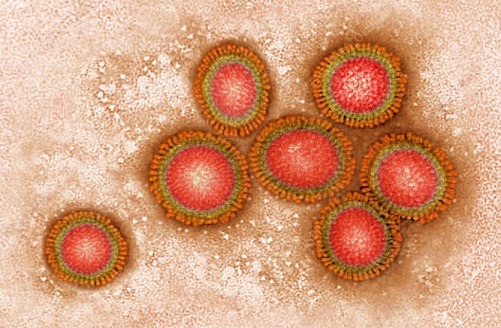Nikhil Prasad Fact checked by:Thailand Medical News Team Nov 24, 2025 1 hour, 20 minutes ago
Medical News: New Clues Hidden in the Flu Virus Genetic Folds
A team of scientists from the Institute of Bioorganic Chemistry of the Polish Academy of Sciences, Ensemble3 in Warsaw, and the Mossakowski Medical Research Institute has uncovered a surprising structural weakness inside the influenza A virus. Their study focused on unusual shapes formed within the virus RNA called G-quadruplexes or G4s. These shapes act like tiny knots in the genetic material and may influence how the virus grows and multiplies. According to this
Medical News report, the researchers examined whether two known G4-binding compounds, TMPyP4 and BRACO-19, could attach to and disrupt these structures.
 Scientists identify hidden RNA structures in influenza that could be targeted to block virus replication.
How the Researchers Tested the Virus Secret Structures
Scientists identify hidden RNA structures in influenza that could be targeted to block virus replication.
How the Researchers Tested the Virus Secret Structures
The team looked at three G-quadruplex forming segments from the influenza A H1N1 genome. Using a method that measures how far an enzyme can travel along RNA before being blocked, the scientists showed that both TMPyP4 and BRACO-19 slowed down or stopped the process whenever a G4 structure was present.
This effect was stronger in natural G4 sequences than in mutated ones, confirming that the ligands were targeting the quadruplex knots specifically. The reverse transcription tests showed that the 1Q structure was the most sensitive, with TMPyP4 blocking cDNA formation at much lower concentrations than required for the other G4 sequences.
How the Ligands Attach to the G4 Structures
Advanced techniques such as isothermal titration calorimetry, fluorescence spectroscopy, circular dichroism, and UV melting were used to explore the binding behavior of the ligands. TMPyP4 was found to interact with two different sets of binding sites on the RNA and showed exceptionally strong attachment to the 11Q variant. BRACO-19, while smaller in size, also bound strongly but followed a different binding pattern with a single primary binding site. Both ligands slightly influenced the thermal stability of the G4 structures but did not disrupt their overall shape, meaning the G4 folds remained intact even when bound.
Impact on Flu Virus Replication
The researchers tested whether these compounds could affect actual influenza virus activity. Using a minireplicon system that imitates viral replication inside cells, they discovered that TMPyP4 significantly suppressed influenza replication. This suggests that targeting G-quadruplex structures inside the viral genome may be a new antiviral strategy, especially since these G4 motifs are conserved across different strains.
Conclusions
This study reveals that influenza A virus RNA forms stable G-quadruplex structures that can be targeted by small molecules like TMPyP4 and BRACO-19. Although their effects vary between different G4 segments, the ability of TMPyP4 to inhibit viral replication shows strong potential for future antiviral drug development. By uncovering how these compounds bind and influence G4 stability, the r
esearchers provide fresh insights into a new class of antiviral targets. Their work also highlights that even small changes in viral RNA structure can create vulnerabilities that may one day be used to slow or stop flu infections, opening the door to novel flu treatments that work very differently from today’s antiviral drugs.
The study findings were published in the peer reviewed journal PLOS One.
https://journals.plos.org/plosone/article?id=10.1371/journal.pone.0335975
For the latest on Influenza, keep on logging to Thailand
Medical News.
Read Also:
https://www.thailandmedical.news/articles/influenza-or-flu
